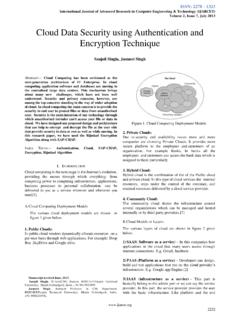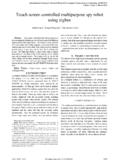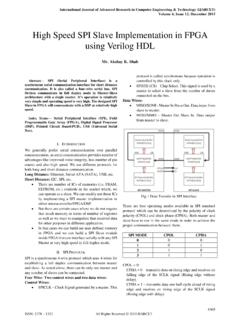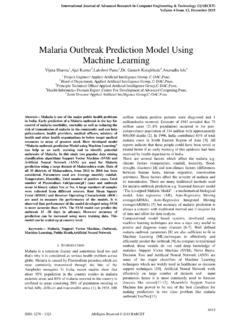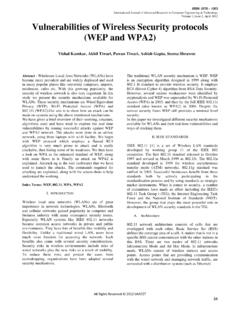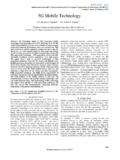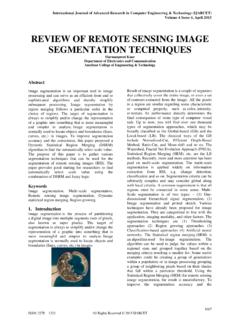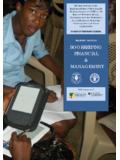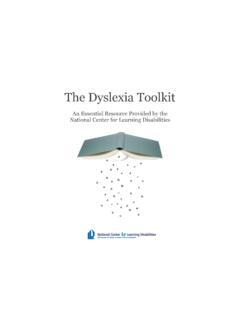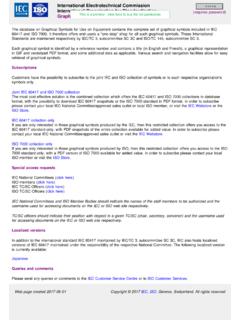Transcription of A REVIEW ON SPEECH TO TEXT CONVERSION METHODS
1 International Journal of Advanced Research in Computer Engineering & Technology (IJARCET) Volume 4 Issue 7, July 2015 ISSN: 2278 1323 All Rights Reserved 2015 IJARCET 3067 A REVIEW ON SPEECH TO TEXT CONVERSION METHODS Khilari1 1 Department of E&TC Engineering. , Ahmednagar. Savitribai Phule University of Pune. Prof. Bhope V. 2 Department of E&TC Engineering. , Ahmednagar. Savitribai Phule University of Pune. ABSTRACT: SPEECH is the first important primary need, and the most convenient means of communication between people. The communication among human computer interaction is called human computer interface. This paper gives an overview of major technological perspective and appreciation of the fundamental progress of SPEECH to text CONVERSION and also gives overview technique developed in each stage of classification of SPEECH to text CONVERSION .
2 A comparative study of different technique is done as per stages. This paper concludes with the decision on future direction for developing technique in human computer interface system in different mother tongue and it also discusses the various techniques used in each step of a SPEECH recognition process and attempts to analyze an approach for designing an efficient system for SPEECH recognition. However, with modern processes, algorithms, and METHODS we can process SPEECH signals easily and recognize the text. In this system, we are going to develop an on-line SPEECH -to-text engine. However, the transfer of SPEECH into written language in real time requires special techniques as it must be very fast and almost 100% correct to be understandable. The objective of this REVIEW paper is to recapitulate and match up to different SPEECH recognition systems as well as approaches for the SPEECH to text CONVERSION and identify research topics and applications which are at the forefront of this exciting and challenging field.
3 Keyword : SPEECH To Text CONVERSION , Automatic SPEECH Recognition, SPEECH Synthesis. I. INTRODUCTION : In modern civilized societies for communication between human speeches is one of the common METHODS . Different ideas formed in the mind of the speaker are communicated by SPEECH in the form of words, phrases, and sentences by applying some proper grammatical SPEECH is primary mode of communication among human being and also the most natural and efficient form of exchanging information among human in SPEECH . By classifying the SPEECH with voiced, unvoiced and silence (VAS/S) an elementary acoustic segmentation of SPEECH which is essential for SPEECH can be considered. In succession to individual sounds called phonemes this technique can almost be identical to the sounds of each letter of the alphabet which makes the composition of human SPEECH .
4 Most of the Information in digital world is available to a few who can read or understand a scrupulous language. Language technologies can provide solutions in the form of ordinary interfaces so the digital content can reach to the masses and facilitate the exchange of information across different people speaking different languages[4]. These technologies play a vital role in multi-lingual societies such as India which has about 1652 dialects/native languages. SPEECH to Text CONVERSION take input from microphone in the form of SPEECH & then it is converted into text form which is display on desktop. SPEECH processing is the study of SPEECH signals, and the various METHODS which are used to process them. In this process various applications such as SPEECH coding, SPEECH synthesis, SPEECH recognition and speaker recognition technologies; SPEECH processing is employed.
5 Among the above, SPEECH recognition is the most important one. The main purpose of SPEECH recognition is to convert the acoustic signal obtained from a microphone or a telephone to generate a set of words [13, 23]. In order to extract and determine the linguistic information conveyed by a SPEECH wave we have to employ computers or electronic circuits. This process is performed for several applications such as security device, household appliances, cellular phones ATM machines and computers. Survey of these paper deals with different METHODS of SPEECH to text CONVERSION which is useful for different languages such as Phonem to Graphem method, CONVERSION for Bengali language, HMM based SPEECH synthesis METHODS etc[17]. 1. Type of SPEECH : SPEECH recognition system can be separated in different classes by describing what type of ullerances they can recognize [1].
6 Isolated Word: Isolated word recognizes attain usually require each utterance to have quiet on both side of sample windows. It accepts single words or single utterances at a time .This is having Listen and Non Listen state . Isolated utterance might be better name of this class. Connected Word: Connected word system are similar to isolated words but allow to divide or separate sound to be run together minimum pause between them. International Journal of Advanced Research in Computer Engineering & Technology (IJARCET) Volume 4 Issue 7, July 2015 ISSN: 2278 1323 All Rights Reserved 2015 IJARCET 3068 Continuous SPEECH : Continuous SPEECH recognizers allows user to talk almost naturally, while the computer determine the content. Recognizer with continues SPEECH capabilities are some of the most difficult to create because they utilize unique sound and special method to determine utterance boundaries.
7 Spontaneous SPEECH : At a basic level, it can be thought of as SPEECH that is natural sounding and not rehearsed. An ASR System with spontaneous SPEECH ability should be able to handle a different words and variety of natural SPEECH feature such as words being run together. 2. Types of Speaker Model: All speakers have their special voices, due to their unique physical body and personality. SPEECH recognition system is broadly classified into main categories based on speaker models, namely, speaker dependent and speaker independent [1]. Speaker independent models: Speaker independent systems are designed for variety of speakers. It recognizes the SPEECH patterns of a large group of people. This system is most difficult to develop, most expensive and offers less accuracy than speaker dependent systems. However, they are more flexible.
8 Speaker dependent models: Speaker dependent systems are designed for a specific speaker. This systems are usually easier to develop, cheaper and more accurate, but not as flexible as speaker adaptive or speaker independent systems. They are generally more accurate for the particular speaker, but much less accurate for others speakers. 3. Types of Vocabulary: The size of vocabulary of a SPEECH recognition system affects the complexity, processing necessities, performance and the precision of the system. Some applications only require a few words ( numbers only), others require very large dictionaries ( direction machines). In ASR systems the types of vocabularies can be classified as follows. a. Small vocabulary - ten of words b. Medium vocabulary - hundreds of words c. Large vocabulary thousands of words d.
9 Very-large vocabulary tens of thousands of words e. Out-of-Vocabulary Mapping a word from the vocabulary into the unknown word. Apart from the above characteristics, the environment variability, channel variability, speaker style, sex, age, speed of SPEECH also make the ASR system more complex. But the efficient ASR systems must cope with the variability in the signal. II. LITERATURE REVIEW : Lu, Man-Wai and Wan-Chi Siu explains about text-to-phoneme CONVERSION by using recurrent neural networks trained with the real time recurrent learning (RTRL) algorithm [3]. , M.; Bordel, G explains a technique to perform the SPEECH to text CONVERSION as well as an investigational test carried out over a task oriented Spanish corpus are reported & analytical results also. , S.; Akhand, M. A H; Das, ; Hafizur Rahman, explore SPEECH -to-Text (STT) CONVERSION using SAPI for Bangla language.
10 Although achieved performance is promising for STT related studies, they identified several elements to recover the performance and might give better accuracy and assure that the theme of this study will also be helpful for other languages for SPEECH -to-Text CONVERSION and similar tasks [3]. , E., in his paper "Text-to- SPEECH algorithms based on FFT synthesis," present FFT synthesis algorithms for a French text-to- SPEECH system based on diaphone concatenation. FFT synthesis techniques are capable of producing high quality prosodic adjustments of natural SPEECH . Several different approaches are formulated to reduce the distortions due to diaphone concatenation. , Jacques, Daelemans, Walter and Wambacq describes a method to develop the readability of the textual output in a large vocabulary continuous SPEECH recognition system when out-of-vocabulary words occur.
